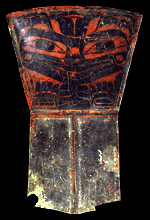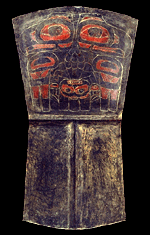
![]()
Coppers
 |
This very large Haida copper shield (117 cm. high) once belonged to Albert Edward Edenshaw. He was a talented shield engraver and sold his decorated coppers as far south as the Fraser River. This copper portrays his female Grizzly Bear crest. Purchased from Mary Yaltatse of Masset in 1970. CMC VII-B-1595 Copper was the ultimate symbol of wealth among the native peoples of the Northwest Coast; like gold, it reflects the brilliance of the sun. According to Nuxalk legend, copper was given to the people by Tsonoqua, who received it from Qomoqua, the master of wealth who lives in a copper house at the bottom of the sea. According to Haida tradition, copper came from the territory of the Eyak people in the Copper River area of Alaska, where it occurs as pure nuggets in the river gravels. In the Prince Rupert harbour shell middens, the use of copper in the form of bracelets, pendants and tubes can be traced back more than 2,000 years, and thus appears to be an early feature of north coast trading and warfare. Throughout the coast, shields made of copper denoted the high rank of their owners and were exchanged at ever higher values between chiefs at potlatch feasts. Among the Kwakwaka'wakw, coppers were particularly associated with the distribution of wealth at weddings. The Haida used coppers as a marker and symbol of wealth, and some wealthy chiefs owned a dozen or more. A copper which belonged to Albert Edward Edenshaw was sold to a Tsimshian chief for eight slaves, one large cedar canoe, one hundred elkskins and eighty boxes of eulachon grease. After a chief's death, his coppers were often fastened on his memorial pole. |
 |
A large Haida copper decorated with a double-headed Eagle (not a traditional Haida crest but adopted from the Imperial Russian form of this bird, introduced by Russian fur traders in Alaska). Collected from Skedans before 1900 by Charles F. Newcombe. On one level the copper represents the ancestors of the owner. It often has a face on the upper portion, and always has a horizontal and vertical line that form a T shape on the lower half -- this represents the backbone or skeleton of the ancestor or the figure depicted on the copper. At a potlatch, to demonstrate his wealth, a chief might give away or even break a copper. In this case, care was taken to keep the T lines intact because bones symbolize the substance from which new life begins in the cycle of reincarnation. This idea is evident in the myths of many indigenous cultures around the world: bones, the most durable part of our bodies, may house the human soul. |
